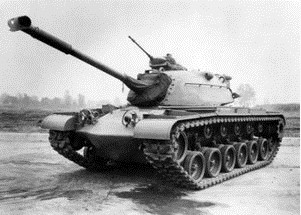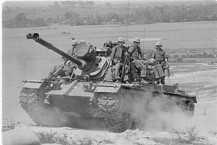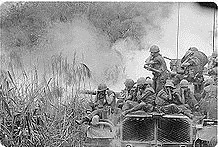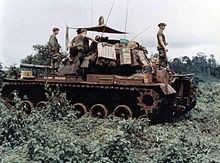
M48 Patton
Wikipedia | 2013-09-29 16:36

| M48 Patton | |
|
M48A1 medium tank |
|
| Type | Medium tank[1] |
| Place of origin |
|
| Service history | |
| In service | 1953–1990s (USA) |
| Wars | Vietnam War, Six Day War, Indo-Pakistani War of 1965, Indo-Pakistani War of 1971, Lebanese Civil War, Iran–Iraq War, Battle of Mogadishu (1993) |
| Production history | |
| Manufacturer | M48: Chrysler, Fisher Tank Arsenal, Ford Motor Company |
| Produced | M48: 1952–1959 |
| Number built | M48: ~12,000 |
| Variants | Many, see the variants section |
| Specifications | |
| Weight | M48: 49.6 short tons (44.3 long tons; 45.0 t) combat ready |
| Length | 9.3 m (30 ft 6 in) |
| Width | 3.65 m (12 ft 0 in) |
| Height | 3.1 m (10 ft 2 in) |
| Crew | 4 (commander, gunner, loader, driver) |
|
|
|
| Armor | 120 mm (4.7 in) |
|
Main armament |
90 mm T54; M48A3 90 mm gun M41; M48A5 and later variants: 105 mm M68 gun |
|
Secondary armament |
.50 cal (12.7 mm) M2 Browning machine gun .30 cal (7.62 mm) M73 Machine gun |
| Engine |
Continental AVDS-1790-5B V12, air-cooled Twin-turbo gasoline engine (early M48s) 810 hp (604 kW) Continental AVDS-1790-2 V12, air-cooled Twin-turbo diesel engine 750 hp |
| Power/weight | 15.1 hp/ton (16.6/tonne) |
| Transmission | General Motors CD-850-4A or -4B, 2 ranges forward, 1 reverse |
| Suspension | Torsion bar suspension |
| Fuel capacity | 200 US gal (760 l; 170 imp gal) |
|
Operational range |
287 mi (462 km) |
| Speed | M48A5: 30 mph (48 km/h) |
The M48 Patton is a medium tank that was designed in the United States. It was the third and final tank[2] to be officially named after General George S. Patton, commander of the U.S. Third Army[3] during World War II and one of the earliest American advocates for the use of tanks in battle[4] It was a further development of the M47 Patton tank. The M48 Patton served as an interim tank in U.S. service until replaced by the U.S. Army's first main battle tank (MBT), the M60.[3] The M48 served as the U.S. Army and Marine Corps's primary battle tank during the Vietnam War. It was widely used by U.S. Cold War allies, especially other NATO countries.
The M48 Patton tank was designed to replace the previous M47 Pattons and M4 Shermans. Although largely resembling the M47, the M48 Patton was a completely new tank design. Some M48A5 models served well into the 1980s with American forces, and many various M48 Patton models remain in service in other countries. The M48 was the last U.S. tank to mount the 90 mm tank gun, with the last model, the M48A5, being upgraded to carry the new standard weapon of the M60, the 105mm gun.
The Turkish Army is the largest operator of the modernized M48 MBT, with more than 1,400 M48s in its inventory (around 1,000 have been phased out/in storage or modified to ARVs).
History

Marines of E Company, 2nd Battalion, 3rd Marines, riding on an M48A3 tank, Vietnam, 1966.
On 27 February 1951, OTCM #33791 initiated the design of the new tank, designated the 90mm Gun Tank T-48 (the prefix letter "T" would be replaced by the prefix "X" beginning with the M60 series tank).[5] A deeper modernization than the M46 and the M47, the M48 featured a new turret, new redesigned hull, and an improved suspension. The hull machine gunner position was removed, reducing the crew to 4. It was essentially a new tank. On 2 April 1953, the Ordnance Technical Committee Minutes (OTCM) order #34765 standardized the last of the Patton series tanks as the 90mm Gun Tank M48 Patton.[3]
Nearly 12,000 M48s were built from 1952 to 1959. The early designs, up to the M48A2C's, were powered by a gasoline 12-cylinder engine which was coupled with an auxiliary 8-cylinder engine (called the "Little Joe"). The gas engine gave the tank a short operating range and were prone to catching fire when hit. This version was considered unreliable but numerous examples saw combat use in various Arab-Israeli conflicts. They also were prone to fire when the turret was penetrated and the hydraulic lines ruptured spewing "cherry juice" (the nickname for the red colored hydraulic fluid) at high pressure into the crew compartment resulting in a fireball. The flashpoint was too low, less than 300 F, causing many burns and deaths to crew members. Beginning in 1959, most American M48s were upgraded to the M48A3 model which featured a diesel power plant. M48s with gas engines, however, were still in use in the US Army through 1968 and through 1975 by many West German Army units including the 124th Panzer Battalion.
M48A3
In February 1963, the US Army accepted its first of 600 M48 Patton tanks that had been converted to M48A3's, and by 1964, the US Marine Corps had received 419 Patton tanks. These Pattons were to be deployed to battle in Vietnam.[3] Because all M48A3 tanks were conversions from earlier models, many characteristics varied among individual examples of this type. M48A3 tanks could have either 3 or 5 support rollers on each side and might have either the early or later type headlight assemblies.
M48A5
In the mid-1970s, the M48A5 upgrade was developed to allow the vehicle to carry the heavier 105 mm gun. This was designed to bring the M48s up to speed with the M60 tanks then in regular use and to simplify ammunition logistics. Most of the M48s were placed into service with reserve units by this time.
By the mid-1990s, the M48s were phased out of U.S. service. Many foreign countries, however, continued to use the M48 models.
Combat service
Vietnam

U.S. Marines riding atop an M48 tank, Vietnam, April 1968.
The M48s saw extensive action during the Vietnam War, over 600 Pattons would be deployed with US Forces during the war.[6] The initial M48s landed with the US Marine 1st and 3rd Tank Battalions in 1965;[7] the Marine 5th Tank Battalion would later become a reinforcement unit. Remaining Pattons deployed to South Vietnam were in three U.S. Army battalions, the 1-77th Armor near the DMZ, the 1-69th Armor in the Central Highlands, and the 2-34th Armor near the Mekong Delta. Each battalion consisted of approximately fifty seven tanks. M48s were also used by Armored Cavalry Squadrons in Vietnam, until replaced by M551 Sheridan Armored Reconnaissance Airborne Assault Vehicles (ARAAV) in the Divisional Cavalry Squadrons. M48A3 tanks remained in service with the 11th Armored Cavalry Regiment until the unit was withdrawn. The M67A1 flamethrower tank (nicknamed the Zippo) was an M48 variant used in Vietnam.
The M48 Patton has the distinction of playing a unique role in an event that was destined to radically alter the conduct of armored warfare.[7] When US forces commenced redeployment operations, many of the M48A3 Pattons were turned over to the Army of the Republic of Vietnam (ARVN) forces, in particular creating the ARVN 20th Tank Regiment; which supplemented their M41 Walker Bulldog units. During the North Vietnamese Army (NVA) Easter Offensive in 1972, tank clashes between NVA T-54/PT-76 and ARVN M48/M41 units became commonplace. But on 23 April 1972, tankers of the 20th Tank Regiment were attacked by an NVA infantry-tank team, which was equipped with the new 9M14M Malyutka (NATO designation: Sagger) wire guided anti-tank missile. During this battle, one M48A3 Patton tank and one M113 Armored Cavalry Assault Vehicle (ACAV) were destroyed, becoming the first losses to the Sagger missile; losses that would echo on an even larger scale a year later during the Yom Kippur War in the Middle East in 1973.[7]

Men of Troop B, 1st Squadron, 10th Cavalry Regiment, 4th Infantry Division, and their M48 Patton tank move through the jungle in the Central Highlands of Vietnam, June 1969.
The M48s performed admirably[8] in Vietnam in the infantry-support role. However, there were few actual tank versus tank battles. One was between the US 1-69th Armor and PT-76 light amphibious tanks of the NVA 202nd Armored Regiment near Ben Het in 1969.[7] The M48s provided adequate protection for its crew from small arms, mines, and rocket-propelled grenades. South Vietnamese M-48s and M-41s fought in the so-called Ho Chi Minh Offensive in 1975. In several incidents, the South Vietnamese Army successfully defeated NVA T-34 and T-55 tanks and even slowed the North's offensive. However since the United States Congress passed bans on the transfer of fuel and ammunition to South Vietnam, the American-made tanks were soon out of ammunition and fuel and were abandoned to the North Vietnamese Army in 1975 which put them in predictably short service of the Vietnamese People's Army after the war ended in May 1975.
M48s, alongside Australian 20 pounder (84mm) gunned[9] Centurions of the 1st Armoured Regiment,[7] were the only vehicles in Vietnam that could reasonably protect their crews from land mines. They were often used for minesweeping operations along Highway 19 in the Central Highlands, a two lane paved road between An Khe and Pleiku. Daily convoys moved both ways along Highway 19. These convoys were held up each morning while the road was swept for mines. At that time, minesweeping was done by soldiers walking slowly over the dirt shoulders of the highway with hand-held mine detectors. During this slow process, convoys would build up into a dangerously inviting target for the enemy. As a result a faster method was improvised. One M48 lined up on each side of the road, with one track on the dirt shoulder and the other track on the asphalt; then they raced to a designated position miles away. If M48s made it without striking a mine, the road was clear and the convoys could proceed. In most cases, an M48 that struck a land mine in these operations only lost a road wheel or two in the explosion; seldom was there any hull damage which would be considered "totaling" the tank.[9]
Indo-Pakistani Wars
M47s and M48s were again used in tank warfare by the Pakistan Army against Indian Army's Centurion and M4 Sherman tanks in the Indo-Pakistani War of 1965 with some good results. In the Rann of Kutch the tanks proved surprisingly nimble in marshy terrain, and Pakistani forces drove back Indian incursions. In Kashmir and Punjab, the tank had its first real test. During Operation Grand Slam, Pakistani tank forces broke through the Indian lines very quickly, and defeated armored counterattacks. The Pakistanis used approximately a division worth of tanks though not all were Pattons. The Patton failed to live up to expectations in the Battle of Asal Uttar, where about 97 Pakistani tanks were lost, the majority of them being Pattons. Later the tank was the main Pakistani tank at the Battle of Chawinda and its performance at that battle was deemed satisfactory.The Patton was later used by Pakistan in the Indo-Pakistani War of 1971, with mixed results. In a repetition of 1965, Pattons spearheaded the Pakistani advance through Chamb, and the Patton was the main Pakistani tank at Shakarghar. In the latter battle, a brigade of tanks (the Changez Force) successfully resisted the Indian advance, in a repeat of Chawinda. However, in what became known as Pakistan's Charge of the Light Brigade, a counterattack led by 13th Lancers and 31st Cavalry was mauled by the Indian 54th Division around Battle of Barapind. India later set up a war memorial named "Patton Nagar" ("Patton City") in Khemkaran District, where the captured Pakistani Patton tanks are displayed.
Analyzing their performance, the Pakistani Army held that the Patton was held in reasonably high esteem by both sides and that tactics were to blame for the debacle at Asal Uttar.[citation needed] However, a U.S. study of the battles in South Asia concluded that the Patton's armor could in fact be penetrated by the 20 pounder gun (84 mm) of the Centurion as well as the 75 mm gun of the AMX-13.
Middle East
M48s were also used with mixed results during the 1967 Six-Day War. On the Sinai front, Israeli M48s up-gunned with 105 mm L7 rifled guns were used with success against Egyptian T-34s and SU-100s supplied by the Soviet Union in the second battle of Abu-Ageila.
However, on the West Bank front, Jordanian M48s were often defeated by Israeli WWII-era M4 Shermans (M-51s up-gunned with 105 mm guns). In pure technical terms the Pattons were far superior to the Shermans, with shots at more than 1,000 meters simply glancing off the M48s' armor; However the 105 mm gun of the Israeli Shermans fired a HEAT round designed to defeat the T-62 tank which was the Soviet response to the M48's successor in US service, the M60. The Jordanian Pattons' failure on the West Bank could also be attributed to Israeli air superiority. The Israeli Army captured about 100 Jordanian M48 and M48A1 tanks and pressed them into service in their own units after the war.
However, on the West Bank front, Jordanian M48s were often defeated by Israeli WWII-era M4 Shermans (M-51s up-gunned with 105 mm guns). In pure technical terms the Pattons were far superior to the Shermans, with shots at more than 1,000 meters simply glancing off the M48s' armor; However the 105 mm gun of the Israeli Shermans fired a HEAT round designed to defeat the T-62 tank which was the Soviet response to the M48's successor in US service, the M60. The Jordanian Pattons' failure on the West Bank could also be attributed to Israeli air superiority. The Israeli Army captured about 100 Jordanian M48 and M48A1 tanks and pressed them into service in their own units after the war.
M48s were used by the Lebanese Army, the Christian Lebanese Forces militia, the Druze Progressive Socialist Party militia and the South Lebanon Army in the Lebanese Civil War. The Lebanese Army still operates about 100 M48s. In 2007, during the 2007 North Lebanon conflict Lebanese Army M48s shelled militant outposts in a refugee camp.[10]
Together with the M47, M48 tanks were used by the Turkish Armed Forces during the Turkish invasion of Cyprus in 1974. The Turkish occupation forces continue to use M48 tanks today.
Share this page



















